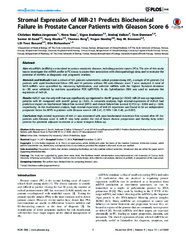Large-scale secretome analyses unveil the superior immunosuppresive phenotype of umbilical cord stromal cells as compared to other adult mesenchymal stromal cells
Permanent link
https://hdl.handle.net/10037/14821Date
2019-02-20Type
Journal articleTidsskriftartikkel
Peer reviewed
Abstract
Mesenchymal stromal cells (MSCs), given their regenerative potential, are being investigated as a potential
therapeutic tool for cartilage lesions. MSCs express several bioactive molecules which act in a paracrine
fashion to modulate the tissue microenvironment. Yet, little is known about the divergence of these signalling
molecules in different MSC populations. The present study investigated secretomes of stromal cells harvested
from Hoffa’s fat pad (HFPSCs), synovial membrane (SMSCs), umbilical cord (UCSCs) and cartilage (ACs)
by quantitative liquid chromatography-mass spectrometry (LC-MS/MS) proteomics. Also, multiplex protein
arrays and functional assays were performed to compare the constitutive immunomodulatory capabilities
of different MSCs. Proteins involved in extracellular matrix degradation and inflammation, such as matrix
metalloproteinases (MMPs), interleukin (IL)-17 and complement factors, were downregulated in UCSCs
as compared to adult cell sources. Additionally, secretion of transforming growth factor (TGF)-β1 and
prostaglandin E2 (PGE2) was enhanced in UCSC supernatants. UCSCs were superior in inhibiting peripheral
blood mononuclear cell (PBMC) proliferation, migration and cytokine secretion as compared to adult
stromal cells. SMSCs significantly suppressed the proliferation of PBMCs only if they were primed with
pro-inflammatory cytokines. Although all cell types repressed human leukocyte antigen-DR isotype (HLADR) surface expression and cytokine release by activated macrophages, only UCSCs significantly blocked
IL-6 and IL-12 production. Furthermore, UCSCs supernatants increased aggrecan gene expression in twodimensional chondrocyte cultures. The data demonstrated that UCSCs displayed superior anti-inflammatory
and immunosuppressive properties than stromal cells from adult tissues. This allogeneic cell source could
potentially be considered as an adjuvant therapy for articular cartilage repair.
Description
Source at https://doi.org/10.22203/eCM.v037a10. This article is distributed in accordance with Creative Commons Attribution Licence
(http://creativecommons.org/licenses/by-sa/4.0/).
Publisher
AO Research Institute DavosCitation
Islam, A., Urbarova, I., Bruun, J.A. & Martinez-Zubiaurre, I. (2018). Large-scale secretome analyses unveil the superior immunosuppressive phenotype of umbilical cord stromal cells as compared to other adult mesenchymal stromal cells. European Cells and Materials, 37, 153-174. https://doi.org/10.22203/eCM.v037a10Metadata
Show full item recordCollections
Related items
Showing items related by title, author, creator and subject.
-
Crosstalk between AML and stromal cells triggers acetate secretion through the metabolic rewiring of stromal cells
Vilaplana-Lopera, Nuria; Cuminetti, Vincent; Almaghrabi, Ruba; Papatzikas, Grigorios; Rout, Ashok Kumar; Jeeves, Mark; González, Elena; Alyahyawi, Yara; Cunningham, Alan; Erdem, Ayşegül; Schnütgen, Frank; Raghavan, Manoj; Potluri, Sandeep; Cazier, Jean-Baptiste; Schuringa, Jan Jacob; Reed, Michelle AC; Arranz, Lorena; Günther, Ulrich L; Garcia, Paloma (Journal article; Tidsskriftartikkel; Peer reviewed, 2022-09-02)Acute myeloid leukaemia (AML) cells interact and modulate components of their surrounding microenvironment into their own benefit. Stromal cells have been shown to support AML survival and progression through various mechanisms. Nonetheless, whether AML cells could establish beneficial metabolic interactions with stromal cells is underexplored. By using a combination of human AML cell lines and AML ... -
Nominal and achieved stromal ablation depth after myopic transepithelial photorefractive keratectomy: implications for residual stromal thickness calculation
Feng, Yue; Nitter, Tore Arnstein; Liu, Xu; Stojanovic, Aleksandar (Journal article; Tidsskriftartikkel; Peer reviewed, 2024-09-02)Background - The primary objective of this investigation was to compare the nominal central ablation depth with the achieved central corneal stromal ablation depth after StreamLight transepithelial photorefractive keratectomy (tPRK) for myopia with WaveLight® laser by Alcon Laboratories, TX, USA.<p> <p>Methods - This ambispective study encompassed a retrospective analysis of 40 eyes who underwent ... -
Stromal Expression of MiR-21 Predicts Biochemical Failure in Prostate Cancer Patients with Gleason Score 6
Melbø-Jørgensen, Christian Nordahl; Ness, Nora; Andersen, Sigve; Valkov, Andrey Yurjevich; Dønnem, Tom; Al-Saad, Samer; Kiselev, Yury; Berg, Thomas; Nordby, Yngve; Bremnes, Roy M.; Busund, Lill-Tove; Richardsen, Elin (Journal article; Tidsskriftartikkel; Peer reviewed, 2014)


 English
English norsk
norsk


